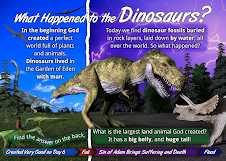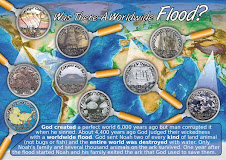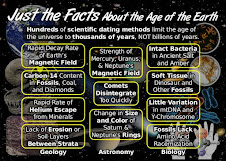County Fair's Creation Booth Smeared by Media
by Brian Thomas, M.S. *
A part-time nurse from West Bend, Wisconsin, set up an interactive creation-based booth with a sign reading "Interpret the Evidence" at a local county fair. The Wisconsin State Journal reported on Mary Weigand's booth with the headline "Creationist seeks to debunk scientific fact at Dane County Fair."1 But was she actually trying to debunk "scientific fact," or was this headline just a mudslinging smear?
By examining fossils on display, booth attendees investigated for themselves whether or not fossils show a gradual transition between life forms, as Darwinism predicts. The booth presented an alternative scientific explanation that appears to fit the fossil data much better. Each visitor was left to discern whether fossils show discrete created kinds with no undisputed transitions between forms, as biblical creation predicts.2The news response to this booth claimed that the idea that the world is thousands of years old is incompatible with "techniques such as radioactive isotope dating." Supposedly, these techniques "repeatedly conclude that some geological features are hundreds of millions of years old."1 But what if overwhelming scientific evidence actually demands that the world is thousands, not millions or billions, of years old, and that the radioisotope dating techniques are unreliable? Weigand may well be familiar with these reports, unlike the State Journal reporter and the evolutionists he interviewed.
Scientific evidence has clearly shown radioisotope dating to be completely untrustworthy.3 Radioisotope-derived ages are typically in conflict with other published results that use different isotopes, or even the same isotopes published at different times. Radioisotope age assignments of rock samples of known age have always reported at orders of magnitude older than the real age of the rock. For example, a 10-year-old rock that formed in the crater of Mount St. Helens was dated at 350,000 years, while another technique dated the same rock at over two million years.4
A Wisconsin-based evolutionary botanist said that the booth "is a testament to the power of belief and the difference between belief and science."1 But his statement is wrong, because it assumes that science does not involve belief, when in fact belief is a fundamental requirement for operational science. Prior to investigation, any scientist must first believe that the world operates according to regular principles, that his or her study results will meaningfully correlate to reality, and that there is such a thing as truthful reality. These beliefs find their foundation only in biblical Christianity.5
The assertion that science is separated from belief also wrongly assumes that belief in creation does not involve scientific examination of evidence. This assumption is convenient if a person prefers to ignore the reams of scientific evidence that point to recent, special creation.6
The claim that this booth is attempting "to debunk scientific fact" is apparently a shallow slander. Instead, it looks as though Weigand and her sponsors actually promote just the opposite approach: Encouraging people to do better science by interpreting hard evidence using common sense, instead of relying on the dogmatic propaganda that is necessary to prop up evolution's failed paradigm.
References
- Erickson, D. Creationist seeks to debunk scientific fact at Dane County Fair. Wisconsin State Journal. Posted on host.madison.com July 22, 2011, accessed August 5, 2011.
- For more information, see Fossils Show Stasis and No Transitional Forms on www.icr.org.
- For one example, see Humphreys, D. 2006. A Tale of Two Hourglasses. Acts & Facts. 35 (12). Related articles are available at www.icr.org/creation-radiometric.
- Austin, S. A. 1996. Excess Argon within Mineral Concentrates from the New Dacite Lava Dome at Mount St. Helens Volcano. Journal of Creation, formerly Creation Ex Nihilo Technical Journal. 10 (3): 335-343.
- Lisle, J. 2009. The Ultimate Proof of Creation. Green Forest, AR: Master Books, 39-41.
- For a sampling of this evidence, visit the Evidence from Science site on www.icr.org.
* Mr. Thomas is Science Writer at the Institute for Creation Research.
Link to article
Link to article







